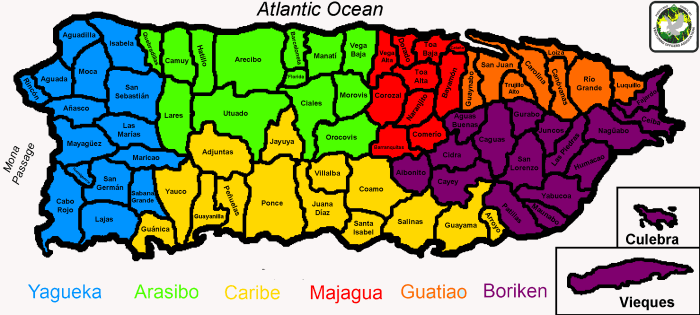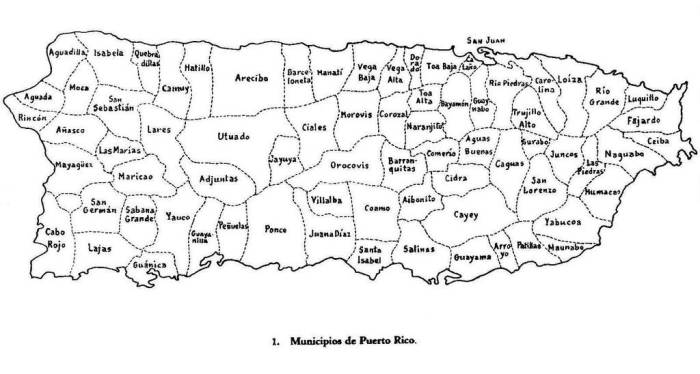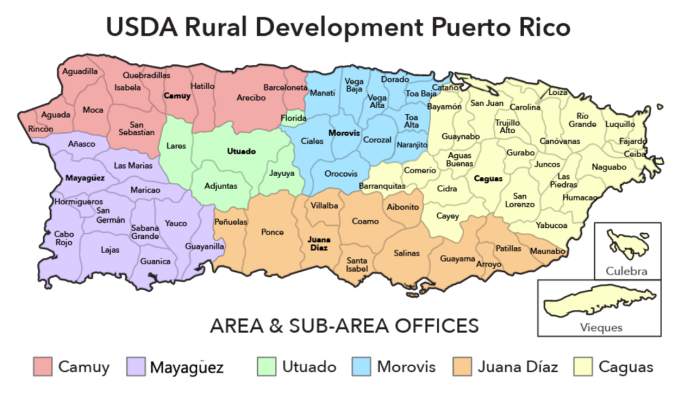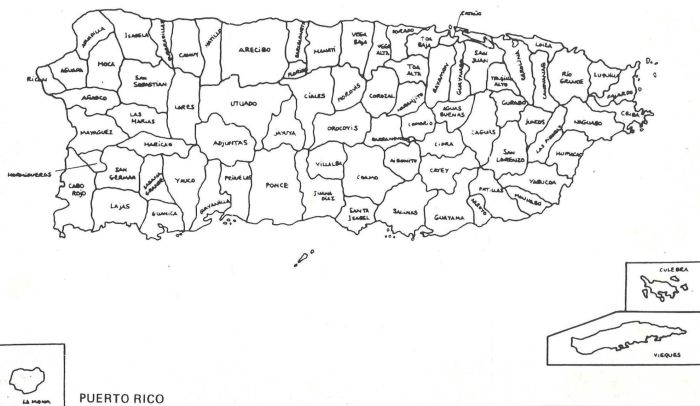Welcome to our comprehensive guide to Puerto Rico Mapa con Pueblos! Immerse yourself in the vibrant tapestry of Puerto Rico’s municipalities, where history, culture, and natural beauty intertwine. From the bustling streets of San Juan to the tranquil shores of Vieques, this guide will take you on a journey through the heart and soul of Puerto Rico.
Within these pages, you’ll find detailed descriptions of each of Puerto Rico’s 78 municipalities, organized alphabetically for your convenience. Discover their unique geographic locations, cultural influences, and economic significance. Whether you’re a seasoned traveler or a first-time visitor, this guide will empower you to explore Puerto Rico’s rich tapestry of destinations.
Puerto Rico Overview
Puerto Rico, officially the Commonwealth of Puerto Rico, is an unincorporated territory of the United States located in the Caribbean Sea. Its history is marked by Spanish colonization, American annexation, and ongoing debates about its political status.
Geographic Location and Significance
Puerto Rico lies east of the Dominican Republic and west of the US Virgin Islands, forming part of the Greater Antilles archipelago. Its strategic location has made it a vital hub for trade, tourism, and military operations throughout history.
Political Status and Relationship with the United States
Puerto Rico has a complex political relationship with the United States. Since 1898, it has been an unincorporated territory, meaning it is under US jurisdiction but not a state. Puerto Ricans are US citizens but cannot vote in presidential elections and have limited representation in Congress.
The island’s political status has been a subject of ongoing debate, with three main options: statehood, independence, or maintaining the current territorial status. Referendums have been held on the issue, but none have resulted in a clear consensus.
Municipalities of Puerto Rico

Puerto Rico is divided into 78 municipalities, each with its own unique history, culture, and attractions. These municipalities are further organized into seven regions: Bayamón, Caguas, Fajardo, Mayagüez, Ponce, San Juan, and Utuado.
The following table lists all 78 municipalities of Puerto Rico, organized alphabetically within their respective regions:
Bayamón Region
| Municipality | Region |
|---|---|
| Bayamón | Bayamón |
| Cataño | Bayamón |
| Guaynabo | Bayamón |
| Toa Alta | Bayamón |
| Toa Baja | Bayamón |
Caguas Region, Puerto rico mapa con pueblos
| Municipality | Region |
|---|---|
| Aguas Buenas | Caguas |
| Caguas | Caguas |
| Cayey | Caguas |
| Cidra | Caguas |
| Gurabo | Caguas |
| Humacao | Caguas |
| Juncos | Caguas |
| Las Piedras | Caguas |
| Maunabo | Caguas |
| Naguabo | Caguas |
| Patillas | Caguas |
| San Lorenzo | Caguas |
| Yabucoa | Caguas |
Fajardo Region
| Municipality | Region |
|---|---|
| Ceiba | Fajardo |
| Culebra | Fajardo |
| Fajardo | Fajardo |
| Luquillo | Fajardo |
| Naguabo | Fajardo |
| Río Grande | Fajardo |
| Vieques | Fajardo |
Mayagüez Region
| Municipality | Region |
|---|---|
| Añasco | Mayagüez |
| Cabo Rojo | Mayagüez |
| Hormigueros | Mayagüez |
| Lajas | Mayagüez |
| Las Marías | Mayagüez |
| Mayagüez | Mayagüez |
| Maricao | Mayagüez |
| Rincón | Mayagüez |
| Sabana Grande | Mayagüez |
| San Germán | Mayagüez |
| San Sebastián | Mayagüez |
| Yauco | Mayagüez |
Ponce Region
| Municipality | Region |
|---|---|
| Adjuntas | Ponce |
| Coamo | Ponce |
| Guánica | Ponce |
| Guayama | Ponce |
| Jayuya | Ponce |
| Juana Díaz | Ponce |
| Ponce | Ponce |
| Santa Isabel | Ponce |
| Villalba | Ponce |
| Yauco | Ponce |
San Juan Region
| Municipality | Region |
|---|---|
| Carolina | San Juan |
| Cataño | San Juan |
| Ciales | San Juan |
| Corozal | San Juan |
| Dorado | San Juan |
| Fajardo | San Juan |
| Florida | San Juan |
| Guaynabo | San Juan |
| Gurabo | San Juan |
| Loíza | San Juan |
| Luquillo | San Juan |
| Manatí | San Juan |
| Orocovis | San Juan |
| Rincón | San Juan |
| Río Grande | San Juan |
| San Juan | San Juan |
| Toa Alta | San Juan |
| Toa Baja | San Juan |
| Trujillo Alto | San Juan |
| Vega Alta | San Juan |
| Vega Baja | San Juan |
| Vieques | San Juan |
Utuado Region
| Municipality | Region |
|---|---|
| Arecibo | Utuado |
| Barceloneta | Utuado |
| Camuy | Utuado |
| Hatillo | Utuado |
| Isabela | Utuado |
| Lares | Utuado |
| Manatí | Utuado |
| Moca | Utuado |
| Quebradillas | Utuado |
| San Sebastián | Utuado |
| Utuado | Utuado |
Geographic Regions of Puerto Rico

Puerto Rico, an archipelago in the Caribbean Sea, is divided into several distinct geographic regions, each with its unique characteristics, cultural influences, and economic activities. These regions play a vital role in shaping the island’s diverse landscape, history, and identity.The
geographic regions of Puerto Rico can be broadly classified into four main areas: the Coastal Plains, the Interior Mountains, the Karst Region, and the Offshore Islands. Each region possesses distinct geological formations, climate patterns, and ecosystems, contributing to the island’s overall biodiversity and natural beauty.
Coastal Plains
The Coastal Plains, located along the northern and southern coasts of Puerto Rico, are characterized by flat or gently sloping terrain. These areas are home to the island’s major cities, including San Juan, Ponce, and Mayaguez. The Coastal Plains are known for their fertile soils, which support a significant portion of Puerto Rico’s agricultural industry.
The region is also a hub for tourism, with popular beaches and coastal attractions.
Interior Mountains
The Interior Mountains, also known as the Cordillera Central, form the central spine of Puerto Rico. This rugged and mountainous region is home to the island’s highest peak, Cerro de Punta, which rises to an elevation of 1,338 meters (4,390 feet).
The Interior Mountains are a vital source of water for Puerto Rico, as they contain several major reservoirs and rivers. The region is also known for its lush forests and diverse plant and animal life.
Karst Region
The Karst Region, located in the northwestern part of Puerto Rico, is characterized by its unique geological formations, including sinkholes, caves, and underground rivers. This region is formed from limestone and other soluble rocks, which have been eroded over time by water.
The Karst Region is home to several natural attractions, including the Camuy River Cave Park, one of the largest cave systems in the world.
Offshore Islands
Puerto Rico also includes several offshore islands, the most notable of which are Vieques and Culebra. These islands are located off the eastern coast of Puerto Rico and are known for their pristine beaches, coral reefs, and marine life. The Offshore Islands are popular destinations for tourism and recreation, offering a unique blend of natural beauty and cultural experiences.The
geographic regions of Puerto Rico are not only diverse in their physical characteristics but also in their cultural and economic significance. Each region has its unique traditions, customs, and economic activities, contributing to the island’s rich and vibrant heritage.
Major Cities and Landmarks: Puerto Rico Mapa Con Pueblos
Puerto Rico, a beautiful island in the Caribbean, boasts a rich history and culture, which is reflected in its vibrant cities and numerous landmarks. From the bustling streets of San Juan to the tranquil beaches of Ponce, Puerto Rico offers a diverse range of urban and natural attractions.
Major Cities
Puerto Rico’s major cities are not only centers of commerce and industry but also repositories of historical and cultural significance. Each city has its own unique character and charm, offering visitors a glimpse into the island’s past and present.
San Juan
San Juan, the capital and largest city of Puerto Rico, is a vibrant metropolis with a rich history dating back to the 16th century. The city is home to numerous historical landmarks, including the Castillo San Felipe del Morro, a UNESCO World Heritage Site that once guarded the entrance to San Juan Bay.
Other notable landmarks include the Catedral de San Juan Bautista, the oldest cathedral in the Americas, and the El Yunque National Forest, a lush rainforest with stunning waterfalls and hiking trails.
Ponce
Ponce, the second-largest city in Puerto Rico, is known for its beautiful architecture and cultural heritage. The city is home to the Museo de Arte de Ponce, which houses a world-renowned collection of European and Puerto Rican art. Other notable landmarks include the Castillo Serrallés, a former sugar plantation that has been converted into a museum, and the Tibes Indigenous Ceremonial Center, a sacred site for the Taíno people.
Mayagüez
Mayagüez, located on the west coast of Puerto Rico, is a major cultural and educational center. The city is home to the University of Puerto Rico at Mayagüez, one of the island’s leading universities. Other notable landmarks include the Museo de Historia de Mayagüez, which tells the story of the city’s past, and the Parque de los Próceres, a beautiful park with a monument to Puerto Rican heroes.
Caguas
Caguas, located in the central region of Puerto Rico, is a thriving city with a strong economy. The city is home to the Plaza Palmer, a bustling public square with shops, restaurants, and a lively nightlife scene. Other notable landmarks include the Museo de Historia de Caguas, which exhibits the city’s rich history, and the Caguas Botanical Garden, a beautiful garden with a variety of plants and flowers.
Bayamón
Bayamón, located just west of San Juan, is a major industrial and commercial center. The city is home to the Plaza de Recreo, a beautiful park with a gazebo and a fountain. Other notable landmarks include the Museo de Arte de Bayamón, which houses a collection of Puerto Rican and international art, and the Parque de las Ciencias Luis A.
Ferré, a science museum with interactive exhibits.
Significant Landmarks
In addition to its major cities, Puerto Rico is home to numerous significant landmarks that attract visitors from around the world. These landmarks range from historical sites to natural wonders, each offering a unique glimpse into the island’s rich heritage and beauty.
Castillo San Felipe del Morro
Castillo San Felipe del Morro, located in San Juan, is a UNESCO World Heritage Site and one of the most iconic landmarks in Puerto Rico. The fortress was built by the Spanish in the 16th century to protect the entrance to San Juan Bay.
It has played a vital role in Puerto Rican history, serving as a military stronghold and a prison. Today, the fortress is open to the public and offers stunning views of the city and the Atlantic Ocean.
Catedral de San Juan Bautista
Catedral de San Juan Bautista, also located in San Juan, is the oldest cathedral in the Americas. It was built in the 16th century and has been a witness to Puerto Rico’s rich history. The cathedral is known for its beautiful architecture and its impressive collection of religious art.
While exploring Puerto Rico’s detailed map showcasing its charming towns, you might stumble upon a delightful diversion in the form of naughty and nice wine duplin . Don’t miss out on this tantalizing experience as you continue your journey through Puerto Rico’s captivating landscapes and vibrant communities.
El Yunque National Forest
El Yunque National Forest, located in the eastern region of Puerto Rico, is the only tropical rainforest in the United States National Forest System. The forest is home to a wide variety of plants and animals, including many endangered species.
It offers visitors a chance to experience the beauty of Puerto Rico’s natural environment and to hike through its lush trails.
Museo de Arte de Ponce
Museo de Arte de Ponce, located in Ponce, is one of the most important art museums in the Caribbean. The museum houses a world-renowned collection of European and Puerto Rican art, including works by Rubens, Goya, and Picasso. It is a must-visit for art enthusiasts and anyone interested in Puerto Rican culture.
Castillo Serrallés
Castillo Serrallés, located in Ponce, is a former sugar plantation that has been converted into a museum. The castle was built in the early 20th century and is a testament to the wealth and power of the Serrallés family, who were once the largest sugar producers in Puerto Rico.
Today, the castle is open to the public and offers visitors a glimpse into the history of the sugar industry in Puerto Rico.
Transportation and Infrastructure

Puerto Rico’s transportation system is essential for its economic development. It includes a network of roads, airports, and ports that connect the island to the mainland United States and other Caribbean destinations.
The island’s road system is extensive, with over 14,000 miles of paved roads. The main highways connect the major cities and towns, and there are also numerous secondary roads that provide access to more remote areas. Puerto Rico is also served by several airports, including the Luis Muñoz Marín International Airport in San Juan, which is the largest and busiest airport in the Caribbean.
Airports
- Luis Muñoz Marín International Airport (SJU) in San Juan is the main airport in Puerto Rico.
- Rafael Hernández Airport (BQN) in Aguadilla is the second-largest airport on the island.
- Ponce Mercedita Airport (PSE) in Ponce is the third-largest airport in Puerto Rico.
- Antonio Rivera Rodríguez Airport (ARE) in Vieques is a small airport that serves the island of Vieques.
- Culebra Airport (CPX) in Culebra is a small airport that serves the island of Culebra.
Ports
- The Port of San Juan is the largest and busiest port in Puerto Rico.
- The Port of Ponce is the second-largest port on the island.
- The Port of Mayagüez is the third-largest port in Puerto Rico.
- The Port of Guayanilla is a major port for the export of petroleum products.
- The Port of Fajardo is a major port for the export of agricultural products.
Puerto Rico’s infrastructure is also essential for its economic development. The island has a reliable electricity grid, a modern telecommunications system, and a well-developed water and sewer system. These infrastructure improvements have helped to attract businesses to the island and have contributed to its economic growth.
However, Puerto Rico’s transportation and infrastructure system faces a number of challenges. The island’s roads are often congested, and the airports are often overcrowded. The island’s infrastructure is also vulnerable to natural disasters, such as hurricanes and earthquakes.
Despite these challenges, Puerto Rico’s transportation and infrastructure system is a vital part of its economy. The island’s government is investing in improving the system, and these improvements are expected to continue to contribute to Puerto Rico’s economic growth.
Economy and Industries
Puerto Rico’s economy is characterized by a diverse mix of industries, with tourism, manufacturing, and agriculture playing significant roles. The island’s economy has faced challenges in recent years, but it also presents opportunities for growth and development.
Tourism
Tourism is a major economic driver in Puerto Rico, contributing significantly to GDP and employment. The island’s beautiful beaches, rich history, and vibrant culture attract millions of visitors annually. Tourism-related businesses include hotels, restaurants, transportation services, and attractions.
Manufacturing
Manufacturing is another important sector in Puerto Rico’s economy. The island has a long history of manufacturing, with a focus on pharmaceuticals, electronics, and food processing. Manufacturing contributes to export earnings and provides jobs for thousands of Puerto Ricans.
Agriculture
Agriculture is a significant contributor to Puerto Rico’s economy, with the island producing a variety of crops and livestock. Major agricultural products include sugarcane, coffee, bananas, and dairy products. Agriculture provides income for farmers and supports the local food supply.
Challenges and Opportunities
Puerto Rico’s economy has faced challenges in recent years, including high unemployment, debt, and a shrinking population. However, there are also opportunities for growth and development. The island’s strategic location, skilled workforce, and tax incentives make it an attractive destination for investment.
Culture and Heritage
Puerto Rico boasts a vibrant and diverse culture, shaped by a rich blend of Spanish, African, and American influences. This fusion has created a unique identity that permeates all aspects of Puerto Rican society.
Spanish Influence
The Spanish colonization of Puerto Rico left an indelible mark on the island’s culture. The Spanish language, architecture, religion, and customs are all deeply rooted in Puerto Rican society. The influence of Spanish literature, music, and art is particularly evident in Puerto Rican cultural expressions.
African Influence
The African diaspora also played a significant role in shaping Puerto Rican culture. Enslaved Africans brought their own traditions, beliefs, and artistic practices to the island, which blended with those of the Spanish colonists. This fusion gave rise to distinct forms of music, dance, and cuisine that are uniquely Puerto Rican.
American Influence
After the Spanish-American War in 1898, Puerto Rico became a territory of the United States. This brought about a new wave of cultural influences, including the English language, American popular culture, and economic practices. While Puerto Ricans have embraced many aspects of American culture, they have also preserved their own distinct traditions and identity.
Music, Art, Literature, and Cuisine
Music, art, literature, and cuisine are integral parts of Puerto Rican culture. The island has produced world-renowned musicians, artists, writers, and chefs who have showcased the beauty and diversity of Puerto Rican culture on a global stage.
- Music:Puerto Rican music is known for its infectious rhythms and diverse genres, including salsa, plena, bomba, and reggaeton.
- Art:Puerto Rican art is vibrant and expressive, with a strong emphasis on color and symbolism. Artists such as Francisco Oller and José Campeche are celebrated for their contributions to Puerto Rican art.
- Literature:Puerto Rican literature has a rich history, with authors such as Julia de Burgos, Luis Lloréns Torres, and Giannina Braschi exploring themes of identity, colonialism, and the Puerto Rican experience.
- Cuisine:Puerto Rican cuisine is a culinary delight, blending Spanish, African, and American influences. Traditional dishes include mofongo, arroz con gandules, and lechón asado.
The culture and heritage of Puerto Rico are a testament to the island’s unique history and the resilience of its people. Through its vibrant music, art, literature, and cuisine, Puerto Rico continues to share its rich cultural heritage with the world.
Environmental Features
Puerto Rico is a land of diverse environmental features, ranging from lush forests to pristine beaches and vibrant coral reefs. These natural resources are essential to the island’s economy, tourism, and quality of life.Forests cover over a quarter of Puerto Rico’s land area, providing habitat for a wide variety of plant and animal species.
The island’s beaches, with their white sands and clear waters, are a major tourist attraction. Coral reefs, found off the coast of Puerto Rico, are home to a multitude of marine life and support the island’s fishing industry.However, Puerto Rico’s environmental features face challenges from human activities such as pollution, deforestation, and overfishing.
The island’s growing population and urbanization have put a strain on its natural resources.Environmental conservation and sustainability are important issues in Puerto Rico. The government has implemented policies to protect the island’s forests, beaches, and coral reefs. These policies include regulations on land use, pollution control, and fishing.
Forests
Forests are a vital part of Puerto Rico’s ecosystem. They provide habitat for wildlife, protect watersheds, and help to regulate the island’s climate. The island’s forests are home to a wide variety of tree species, including mahogany, cedar, and rosewood.
Beaches
Puerto Rico’s beaches are a major tourist attraction. The island has over 270 miles of coastline, with white sand beaches, clear waters, and palm trees. The beaches are popular for swimming, sunbathing, and surfing.
Coral Reefs
Coral reefs are found off the coast of Puerto Rico and are home to a wide variety of marine life. The reefs provide food and shelter for fish, shellfish, and other marine animals. Coral reefs are also important for tourism and the fishing industry.
Population and Demographics
Puerto Rico has a population of approximately 3.2 million people, making it the most populous island in the Caribbean. The population is concentrated in the coastal areas, with the highest density in the San Juan metropolitan area. The island’s population is relatively young, with a median age of 35.2 years.
Age Structure
The population of Puerto Rico is aging, with a growing proportion of elderly people. In 2020, 13.5% of the population was 65 years or older, compared to 9.5% in 2000. The aging population is a result of declining fertility rates and increasing life expectancy.
Gender Distribution
The population of Puerto Rico is slightly female-dominated, with women accounting for 51.3% of the total population. The gender distribution is relatively equal across all age groups, except for the elderly population, where women outnumber men.
Ethnicity
The majority of Puerto Ricans are of Hispanic ethnicity, with 98.1% of the population identifying as Hispanic or Latino. The largest ethnic group is Puerto Rican, accounting for 84.6% of the population. Other ethnic groups include Dominican, Cuban, and American.
Migration
Migration has played a significant role in the population dynamics of Puerto Rico. In the 20th century, there was a large influx of Puerto Ricans migrating to the United States, particularly to New York City. In recent years, there has been a reversal of this trend, with more Puerto Ricans returning to the island.
Social and Political Issues

Puerto Rico faces several social and political challenges, including poverty, inequality, and crime. These issues are deeply intertwined and have a significant impact on the island’s society and development.
Poverty remains a persistent problem in Puerto Rico, with a significant portion of the population living below the poverty line. Economic inequality is also a major concern, with a wide gap between the wealthy and the poor. These disparities contribute to social tensions and make it difficult for many Puerto Ricans to access basic necessities like healthcare, education, and housing.
Crime and Violence
Crime is another pressing issue in Puerto Rico, with high rates of violent crime, including murder, robbery, and assault. The island has been plagued by drug trafficking and gang violence, which have contributed to the high crime rates. The government has implemented various measures to address crime, including increased policing and community-based programs, but the problem persists.
Political Debates and Controversies
Puerto Rico’s political status is a major source of debate and controversy. The island is a US territory, but its residents are not granted the same rights as US citizens. This has led to ongoing discussions about Puerto Rico’s future, with some advocating for statehood, others for independence, and still others for maintaining the current status quo.
These political debates have a significant impact on Puerto Rican society, as they shape the island’s economic, social, and cultural development. The outcome of these debates will have a profound impact on the future of Puerto Rico and its people.
FAQ Guide
What is the largest municipality in Puerto Rico?
San Juan
What is the smallest municipality in Puerto Rico?
Vieques
Which municipality is known for its coffee production?
Yauco
Which municipality is home to the El Yunque rainforest?
Ceiba
Which municipality is known for its surfing beaches?
Rincon